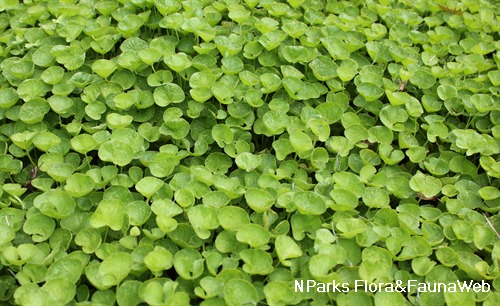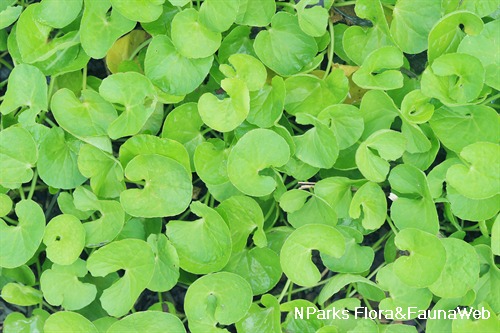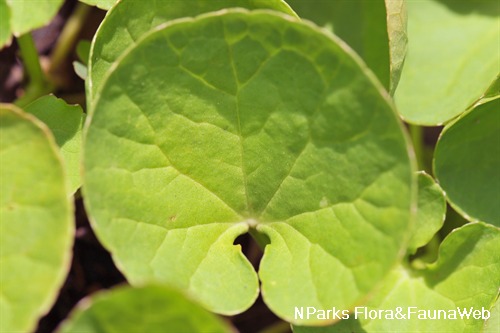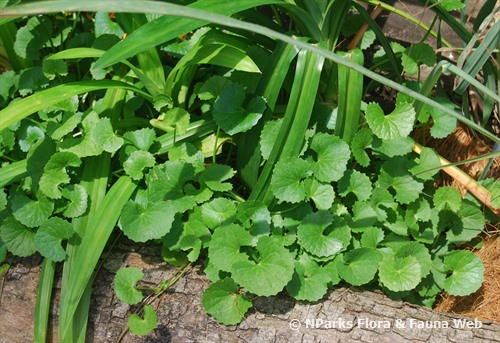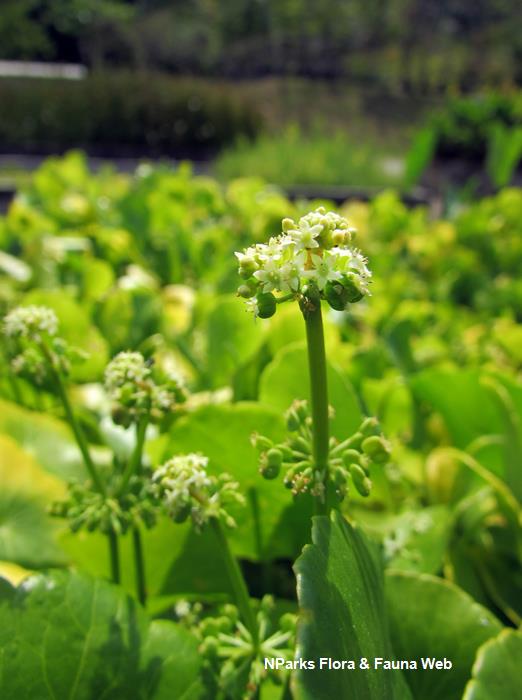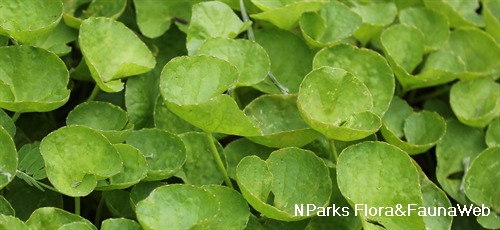
Back
Centella asiatica (L.) Urb.
| Family Name: | Apiaceae (Umbelliferae) |
| Synonyms: | Hydrocotyle asiatica L. |
| Common Name: | Indian Pennywort, Asiatic Pennywort, Gotu Kola, Spadeleaf, 积雪草, 崩大碗 |
Name
Classifications and Characteristics
| Plant Division | Angiosperms (Flowering Seed Plants) (Dicotyledon) |
|---|---|
| Plant Growth Form | Aquatic & Hydrophyte (Waterside / Marginal), Herbaceous Plant, Creeper |
| Lifespan (in Singapore) | Perennial |
| Mode of Nutrition | Autotrophic |
| Maximum Height | 0.2 m |
| Maximum Plant Spread / Crown Width | 1 m |
Biogeography
| Native Distribution | Caucasus, Tropical and Subtropical Old World to Eastern Australia and West Pacific |
|---|---|
| Native Habitat | Aquatic (Freshwater Pond / Lake / River) |
| Preferred Climate Zone | Tropical, Sub-Tropical / Monsoonal |
| Local Conservation Status | Native to Singapore (Least Concern (LC)) |
Description and Ethnobotany
| Growth Form | Perennial herb with a creeping growth habit. |
|---|---|
| Foliage | Bean-shaped leaves have a crenate leaf margin (leaf edge with rounded teeth). |
| Ethnobotanical Uses | Edible Plant Parts : Edible Leaves Food (Fruit or Vegetable) (Herb or Spice) Medicinal: Scientific Evidence of Medicinal Properties In pre-clinical trials, Indian Pennywort showed pain-relieving <6>, anti-cancer <3>, anti-diabetic <1>, anti-inflammation <6>, antioxidant <8> and cholesterol-lowering properties <1> and anti-malarial properties <4> in animals. Traditional Medicinal Uses Research supports the traditional use of Indian Pennywort to treat wounds, burns, sores and skin diseases, such as leprosy. Other traditional uses include using it to improve appetite and digestion. It is important to note that some therapeutic effects from traditional medicinal uses of plants are not currently supported or verified by scientific research. |
Plant Care and Propagation
| Light Preference | Semi-Shade, Full Shade |
|---|---|
| Water Preference | Lots of Water |
| Plant Growth Rate | Moderate |
| Rootzone Tolerance | Moist Soils, Waterlogged Soils |
| Maintenance Requirements | Low |
| Propagation Method | Seed, Stolon / Runner |
Foliar
| Foliage Retention | Evergreen |
|---|---|
| Mature Foliage Colour(s) | Green |
| Mature Foliage Texture(s) | Smooth |
| Foliar Type | Simple / Unifoliate |
| Foliar Arrangement Along Stem | Rosulate / Rosette |
| Foliar Attachment to Stem | Petiolate |
| Foliar Shape(s) | Non-Palm Foliage (Orbicular / Round, Reniform) |
| Foliar Venation | Palmate |
| Foliar Margin | Serrate / Toothed |
| Foliar Apex - Tip | Rounded |
| Foliar Base | Cordate |
Floral (Angiosperm)
| Flower & Plant Sexuality | Bisexual Flowers |
| Flower Colour(s) | White |
|---|---|
| Flower Grouping | Cluster / Inflorescence |
| Flower Location | Axillary |
| Flower Size - Remarks | Less than 3mm |
| Inflorescence Type | Umbel |
| Flower Colour(s) Remarks | Light Purple, Light Pink |
References
| References | <1> Emran, T.B., Dutta, M., Uddin, M.M.N, Nath, A.K. & Uddin, M.Z. (2015). Antidiabetic potential of the leaf extract of Centella asiatica in alloxan-induced diabetic rats. Jahangirnagar University Journal of Biological Science 4(1): 51–59. <2> Gohil K.J., Patel J.A., Gajjar A.K. & Maity, T.K. (2010). Pharmacological review on Centella asiatica: A potential herbal cure-all. Indian Journal of Pharmaceutical Sciences. 72(5): 546–556. <3> Hamid, I.S., Widjaja, N.M.R. & Damayanti, R. (2016). Anticancer activity of Centella asiatica leaves extract in benzo(a)pyrene-induced mice. International Journal of Pharmacognosy and Phytochemical Research 8(1): 80–84. <4> Mavondo, G.A., Mkhwananzi, B.N., Mabandla, M.V. & Musabayabe, C.T. (2016). Asiatic acid influences parasitaemia reduction and ameliorates malaria anaemia in P. berghei infected Sprague-Dawley male rats. BMC Complement Altern Med 16(1): 357-367. <5> Prasesti, G.K. & Kurniati, N.F. (2022). Toxicity studies of Centella asiatica for drug development: Mini review. Biointerface Research in Applied Chemistry 12(6): 8081-8093. <6> Saha, S., Guria, T., Singha, T. & Maity, T.K. (2013). Evaluation of analgesic and anti-inflammatory activity of chloroform and methanol extracts of Centella asiatica Linn. ISRN Pharmacology Article ID 789613 <7> Shukurova, M.K., Myint, D., Yi, S.S., Saw, O.M. & Watanabe, K.N. (2021). Morphological description and ethnobotanical review of the orphan crop Myin-Hkwa (Centella asiatica L.) from Myanmar. Frontiers in Sustainable Food Systems Volume 5, Article ID 680862. <8> Zhao, Y., Shu, P., Zhang, Y.Z., Lin, L.M., Zhou, H.H., Xu, Z.T., Suo, D.Q., Xie, A.Z. & Jin, X. (2014). Effect of Centella asiatica on oxidative stress and lipid metabolism in hyperlipidemic animal models Oxidative Medicine and Cellular Longevity Article ID 154295.<9> Zheng, H.M., Choi, M.J., Kim, J.M., Lee, K.W., Park, Y.H. & Lee, D.H. (2016). In vitro and in vivo Anti-Helicobacter pylori activities of Centella asiatica leaf extract. Preventive Nutrition and Food Science 21(3): 197–201. |
|---|
Image Repository
Others
| Master ID | 30961 |
|---|---|
| Species ID | 5347 |
| Flora Disclaimer | The information in this website has been compiled from reliable sources, such as reference works on medicinal plants. It is not a substitute for medical advice or treatment and NParks does not purport to provide any medical advice. Readers should always consult his/her physician before using or consuming a plant for medicinal purposes. |

